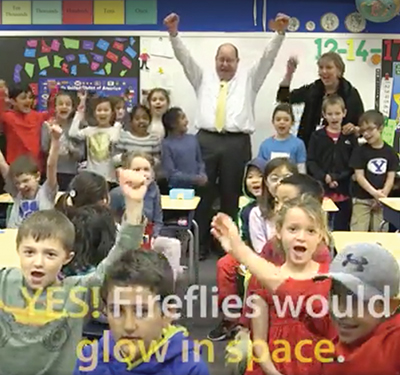‘Would fireflies light up in space?” is a reasonable kind of question only second graders studying the wondrous little bioluminescent beetles might be curious enough to ask.

The Purdue/Cumberland Elementary firefly experiment blasted off Dec. 12, 2017, aboard a Blue Origin rocket and capsule. This photo was of a Blue Origin launch in 2016. Photo by Blue Origin
To find out, students in Maggie Samudio’s class at Cumberland Elementary in West Lafayette posed the question to Purdue University’s astronautics professor Steven Collicott. To answer it as an educational exercise, he teamed students at Purdue’s School of Aeronautics and Astronautics with the second graders to create ZGGE: Zero-Gravity Glow Experiment. The automated experiment would determine if the reaction between the two chemicals that occurs in the bellies of fireflies to create their light would do the same artificially in the belly of a space capsule in the weightlessness of space.
On Dec. 12, 2017, over two years and a sub-orbital flight 60 miles above Earth later, the question was answered aboard a Blue Origin launch. When the capsule reached weightlessness, the rocket’s computer triggered the experiment to begin. A miniature video camera recorded as the plunger of a syringe filled with one of the chemicals used by fireflies was injected into the other. And the answer, we now know, is — “YES!” Fireflies could light up in space.
Blue Origin is an aerospace firm launching commercial payloads and preparing for human spaceflight. Purdue has flown experiments with Blue Origin before. The 12-minute flights blast off from its launch facility in western Texas. Along with ZGGE, the December flight included 11 other commercial, research and education experiments. The weightless environment lasted about three minutes.
 Interest in fireflies at Cumberland took off in 2014 when a student wondered why Indiana had no state insect, and her class began lobbying the Indiana General Assembly to make it Say’s Firefly (a variety discovered by naturalist Thomas Say in New Harmony in 1826). Their efforts were featured in the June 2016 Electric Consumer.
Interest in fireflies at Cumberland took off in 2014 when a student wondered why Indiana had no state insect, and her class began lobbying the Indiana General Assembly to make it Say’s Firefly (a variety discovered by naturalist Thomas Say in New Harmony in 1826). Their efforts were featured in the June 2016 Electric Consumer.
Undeterred by defeats at the Statehouse, the students continued their efforts. This legislative session, they received the backing of Gov. Eric Holcomb who even noted his support for their cause in his State of the State address Jan. 9.
While the students’ fireflies in space question has been resolved with a flight to the edges of the Earth and back, their question as to why there’s no state insect remains up in the air.

To revisit our 2016 story and find links to more info, go to:
electricconsumer.org/carrying-a-torch.
Check out a YouTube video about the experiment:



